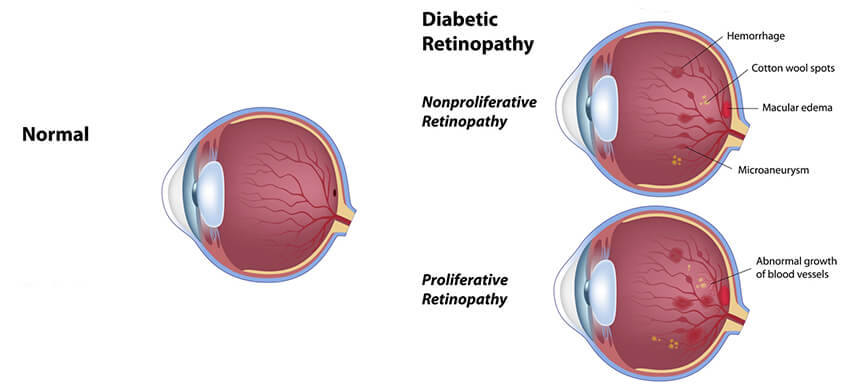Diabetic retinopathy is an entirely preventable condition for those with diabetes. The easiest way to reduce your risks of long-term vision loss is keeping your blood sugar strictly controlled. For those that have been diagnosed with diabetic retinopathy, there is currently no cure available. However, with treatment, diabetic retinopathy can be kept in check, ensuring that little to no vision loss. At Attleboro Ophthalmological Associates, we care about your sight, and will do all that we can to help you keep it.
What is Diabetic Retinopathy?
Diabetic retinopathy occurs when uncontrolled blood sugar levels cause damage to the small blood vessels located on the retina. When these tiny blood vessels are damaged, they leak fluid and blood, which can cause vision loss. Diabetic Retinopathy is a progressive disease, meaning it will get worse over time without treatment.

Types of Diabetic Retinopathy
There are two defined types of diabetic retinopathy: proliferative retinopathy and non-proliferative diabetic retinopathy.
Macular Edema
Non-proliferative diabetic retinopathy (NPDR) is the early stage of diabetic retinopathy. During this stage, symptoms can be non-existent or very mild. NPDR is characterized by bulging and leaking of the blood vessels on the retina. This can lead to swelling on the macula, the part of the retina responsible for central vision.

Proliferative diabetic retinopathy (PDR) is the advanced form of this disease. During this stage, the retina is deprived of oxygen. As a result, new, abnormal blood vessels begin to grow on the retina or optic nerve. These new blood vessels are unstable and are more likely to leak fluid and blood, which can lead to bleeding in the retina or vitreous, sometimes causing irreversible damage to the retina.
Proliferative Diabetic Retinopathy (PDR)
Diabetic Retinopathy Treatments
Treatments depend on the stage of the disease. For the very early stages of NPDR, your doctor may elect to closely monitor your eye. With strict controls of your blood sugars, many signs of early diabetic retinopathy may regress. With more extensive forms of NPDR, your doctor may elect to refer you to a retina specialist for treatments. Treatment may be in the form of retinal laser surgery or injections into or around the eye.
The laser surgery is performed using a slit-lamp microscope, as well as the use of a temporary contact lens to help focus the laser on the retina most accurately. One individual laser treatment may not be enough, and more laser treatment sessions may be required. Sometimes your retinal specialist may prefer to use steroid or anti-VEGF medicines. These medicines are injected either into the eye or around the eye. These medicines have been shown to reduce swelling and the formation of new blood vessels on the retina.
Macular Edema Injection Laser
If you have been diagnosed with diabetic retinopathy, be sure to contact Attleboro Ophthalmological Associates. We are happy to determine the best course of treatment for you. Call today!

